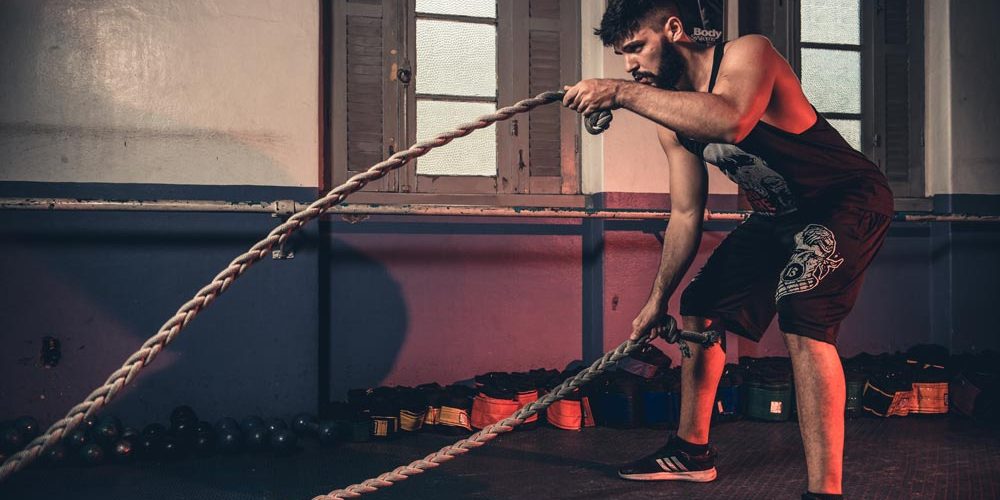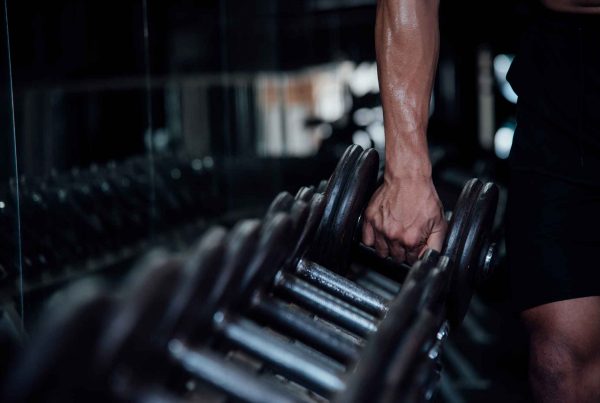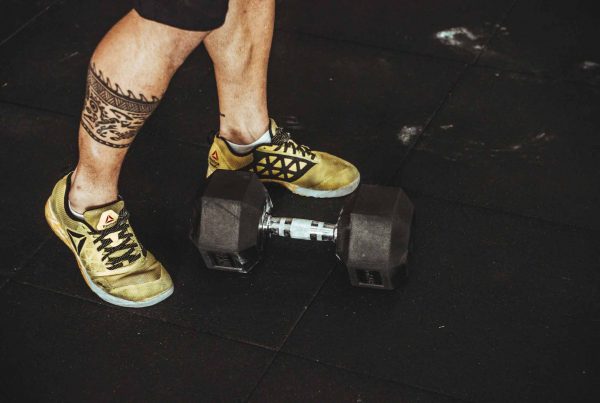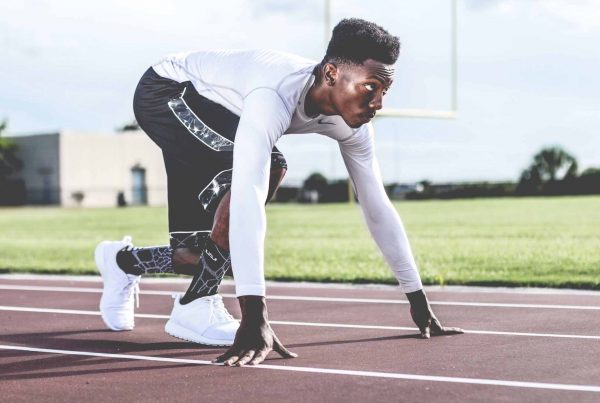Battle ropes, also known as heavy ropes, are used to amplify body conditioning and strength. John Brookfield successfully developed this system in 2006. He taught the technicalities of battle ropes to Special Forces and Olympic wrestling teams.
Canadian experts did a study in which it reveals that 15-minute rounds of battle ropes a week can augment your maximum sit-ups by 7% and maximum press-ups by 24% in only four weeks. Similarly, another study from University of Minnesota shows that ten minutes of battle ropes workout can remarkably increase the metabolic turn after exercise.
Integrating ropes to your routine workout provides a killer cardio exercise, which comes with other amazing aerobically focused activities. Give this article a thorough read if you are a beginner and want to know the nitty-gritty of battle ropes.
Training Benefits
While battle ropes may look overwhelming, they are a simple workout tool that can not only boost your metabolism, but also sculpt your muscles. Through this amazing workout, you can conveniently train the muscles in your abs, glutes and back. Here are some unmatched battle ropes benefits that will certainly compel you to start employing this workout:
Dual Force Dynamic Effect
Ropes have a unique quality of creating a dual-force dynamic effect. This effect utilizes the force created by the ropes’ waves and the force of gravity to ameliorate the human system’s physiological response. This eventually leads to improved body adaptations.Enhanced Mobility
Battle ropes are known to boost your range of motion. A consistent rope practice will not only enhance the movement in your shoulders, ankles, hips and feet, but it will also accelerate the mobility in your grip. You will then feel that performing day-to-day actions have become easier.
Fewer Chances of Injury
Since the adaptation in your body will increase, it will have significant effects on curbing any injuries. If you do not produce enough force to get off of the ground, or your nervous system does not allow for proper sequencing to get off of the ground, it will be extremely hard for you to get injured.

How to Use Battle Ropes
Adam Friedman, a trainer at the Gold’s Gym Fitness Institute, says: “Battle ropes affect your entire body, especially your arms, shoulders, and core, while at the same time sending your calorie burn through the roof.” Here are a number of variables that will make you better understand how you can use battle ropes:
The Handle
You need to make sure that the handle is more challenging to grip as it will strengthen the entire process. Folding the ropes over will double the size you are going to hold.
Distance from the Poll
You need to start with a little slack on the ropes. As you move closer to the poll point, it will become more challenging to get the waves to the end, meaning that you need to yield more power to get the ropes all the way down.
Size of the Ropes
Generally, ropes that are 50 feet long and 1.5 inches thick are used for the wave series. The thicker the ropes, the more challenging it would be to generate waves.
Wave Pace
You can also gauge the speed and size of the wave. A beginner should maintain 120 – 150 alternating waves per minute to furnish the workout smoothly.
Do Battle Ropes Build Muscle?
Most beginners often ask, do battle ropes build muscle? People generally need two things to build muscles – fuel and force. Enough fuel from carbohydrates and proteins intake allow for a smooth hypertrophy process to take place, and enough force to make the muscular-skeletal system adjustable by laying down stronger muscle tissues. So, are the battle ropes sufficient to provide enough force for muscle-building?
Though battle ropes can build muscle, you cannot move the ropes around randomly. You need to use proper progressive overload, in the same way you build muscles with dumbbells and kettlebells. Just like barbell muscle-building, battle ropes will also need consistent repetitions, carried out with enough volume to provide fatigue and a muscle-pump feeling.
Which Muscles Do Battle Ropes Work On?
After watching someone make waves with battle ropes, you would certainly assume that battle ropes are great for the arms. Though the efficiency of this workout on arms cannot be denied, other muscles also get flexibility and robustness. From your hips and shoulders to your legs and feet, battle ropes stimulate everything. Here is an insightful breakdown of how a battle ropes workout for beginners can positively influence your body:
Upper Body Dividends
It would not be an exaggeration if we were to say that the upper body gains the most benefits with battle ropes. As you create waves with your arms using the ropes, the other key parts of your body will also go into overdrive. As you try to maintain the momentum of the ropes, your chest area will also get the stimulus.
Lower Body Dividends
While executing the battle ropes, your lower body will also do as much work as your upper body. The primary reason for this is that your lower body is responsible for maintaining your stability. In addition, doing side to side and back and forth lunges would also put a focus on your glutes, hamstrings and quadriceps.

Techniques To Battle Ropes
Before becoming a master in anything, you first have to learn the fundamental principles of it. Before moving to an advanced stage of battle ropes, here are three basic techniques you can practice as a beginner:The Wave
To furnish this moment impeccably, you need to pick up your ropes using the handshake grip. Then walk the ropes back so that there is no laxity. Subsequently, take two to three steps forward. This will help you maintain the perfect amount of slack to produce balanced waves.
Now slightly bend at the elbow and start raising your one arm to the height of your shoulder. Raise another arm as your first raised arm begins to drop. Continue replacing the arms to keep the waves going.
The Slam
Pick up the ropes using the handshake grip and ensure that there is no slack. Now, bend slightly at the knees, while making sure that you are in the quarter squat position. Raise the handles of the battle ropes while keeping your chest up. Aggressively drive the handles towards the ground once they reach overhead and pretend that you are throwing something to the ground. Once the ropes hit the ground, raise the handles over your head again to start your second repetition.
Hip to Hip
Remove any slack by picking up the ropes as mentioned above. Bend the knees so that you are in a quarter squat. Extend your arms while grabbing the handles of the ropes in your hand. Start the movement by rapidly rotating at your hips to the left and then bring the hands towards your left. Now, immediately spin to the right and then finally bring your hands towards your right hip.
Common Mistakes with Battle Ropes
Undoubtedly, battle ropes are an amazing alternative to High-Intensity Interval Training (HIIT) and cardio, targeting all major muscles, building strength and burning fat. However, it is crucial not to implement this workout inexpertly in order to stay safe. You must avoid these common mistakes while doing this workout if you truly want to endure the eternal advantages of the battle ropes:
Gripping Too Hard
Generally, beginners like to squeeze the ends of ropes too hard. This solid grip will lead to tiring out your grip strength, thereby preventing you from targeting the muscle groups you really want to target. Therefore, hold the ropes firmly but never overdo it. It will save you from the risk of injury in the long run.
Not Applying Variations
Not changing your battle ropes routine will make your body lethargic, and your interest in the activity will fade away. Always try to integrate new variations to your workout in order to keep your mind and body motivated. You can apply alterations by going for longer periods of time, setting yourself up with new challenges, switching routines up, etc.
Too Much Tension in the Ropes
When there is too much tension in the ropes, or you are unfamiliar with the tools, your body will counterbalance the high muscular engagement. In a bid to release the strain in the ropes, take a step or two forward, loosen up the grip, and stand tall when you are making your waves.
Pounding of the Ropes on the Ground
If the ropes pound on the ground every time you make a wave, it means you are a little late on the up motion. You need to practice a lot in order to synchronize your body with the movement of the ropes. Just make sure you are bringing the ropes right back up as soon as they go up.
We hope that this article has introduced you to the fundamentals of battle ropes. Once you have mastered the basics, you can move on to more challenging and advanced battle ropes exercises.









